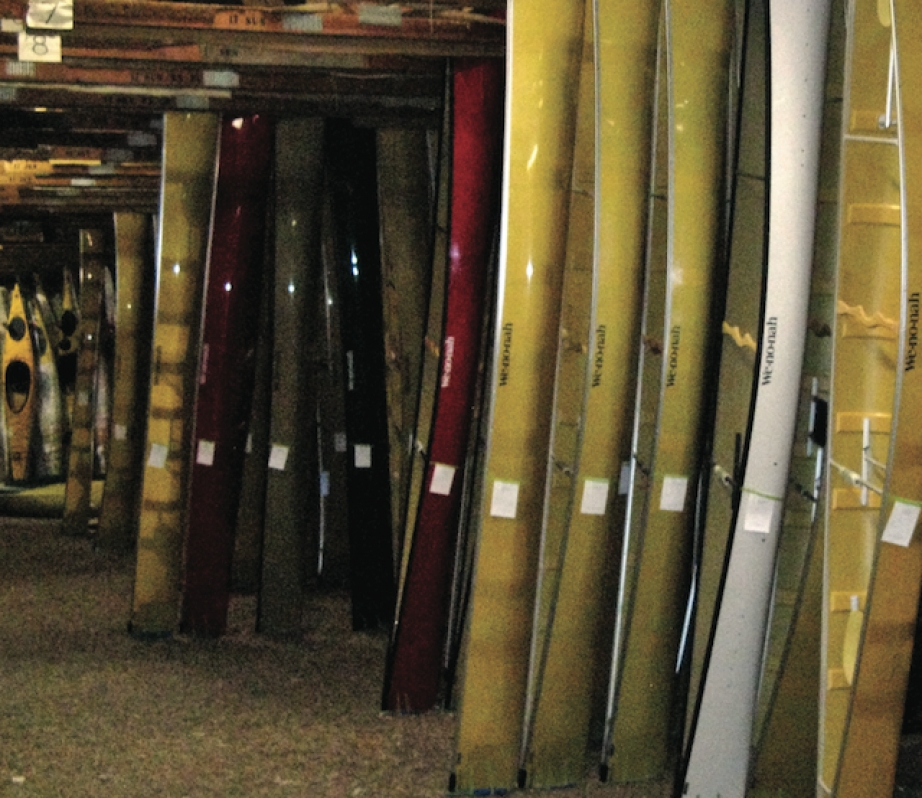The storied poetry of master builders laying cedar strips on an antique form to build a canoe is still present in the manufacture of today’s ultra-light canoes. Although modern kevlar canoes are made in factories using the same space-age materials used to make bulletproof vests and airplanes, their creation still involves equal parts industry, innovation and human skill.
A tour of one such facility feels more like a visit to a grandfather’s workshop than it does a trip to one of Henry Ford’s production lines.
The Wenonah Canoe factory sits at the foot of 600-foot bluffs that overlook the Mississippi River in Winona, Minnesota. Inside, workers create the kind of ultra-light canoes that make long trips easier and short trips faster.
Twenty-five of the 29 Wenonah models are available using the bread-and-butter kevlar ultra-light hull material Wenonah has been developing for more then three decades. The minimal thickness of these hulls means the heaviest touring class canoes weigh in at just 55 pounds. The shortest solo canoes weigh a mere 24 pounds.
Speed and precision in this stage of the process are critical
Proponents of high-end composite hulls will tell you they are stiff, quiet and literally bulletproof.
With work divided among nimble hands and specialized equipment, it takes just a few hours for a hull to take shape. Each style begins in a custom wooden mould.
A trigger man first sprays the inside of the mould with resin. Next comes the kevlar. So there are no seams, a single piece of kevlar three feet wide and up to 25 feet long is laid and pressed by hand into the mould. After the sheet conforms to the interior of the mould, smaller strips are applied to reinforce the ends before another layer of resin and kevlar is applied. With the resin having an easy working time of only about five minutes, speed and precision in this stage of the process are critical.
Smock-clad workers then put the mould, with the burgeoning canoe still inside, on a gurney and wheel it out of the spray booth to harden, like a patient leaving surgery for the recovery room. But the operation is far from over.
Next comes the plastic surgery. After they trim any excess kevlar off, workers lay down a diamond-shaped PVC foam sheet and some 3/8- inch ribs.
The foam sheet and ribs serve three purposes. They stiffen the hull, they provide buoyancy to a hull that is so dense it would barely float if over-turned and they provide a place to attach components to a hull that is otherwise so thin there would be no way to outfit the canoe with things like footrests or side-mounted seats.
A third layer of kevlar is applied to the interior to seal in the foam.
The next step is crucial to reducing the weight of the canoe. Workers lay a plastic bag fitted with four vacuum hoses over the canoe’s interior. Overnight, light suction will remove up to eight pounds of material, slowly extracting any still-hardening resin that hasn’t impregnated the kevlar.
After the excess resin is removed, the PVC foam end tanks are fitted and installed for extra buoyancy and fibreglassed in. With that, the structural aspect of the canoe is complete. Excluding the time spent vacuum bagging, the hands-on labour has so far taken about an hour.
After the canoe has cured, workers free it from the mould using specialized pliers. A ceiling-mounted lift hoists the canoe from the mould and it is taken to another area where the edges are finished off, minor imperfections are made perfect and the hull is buffed.
The canoe then undergoes 45 minutes’ worth of finishing touches such as gunwales, thwarts, deck plates, a yoke and seats. Finally a last buff and, of course, the logo placement means the canoe is ready to push off in all its lightweight glory.
When fresh from the factory, these ultra- light—and bulletproof—canoes are not as aromatic as a cedar canoe, but only the most stubborn traditionalist would deny the worth of a building technique that lets a paddler ease into a favorite lake in the stillness of morning as quietly and effortlessly as possible.

This article first appeared in the Spring 2009 issue of Canoeroots Magazine.




